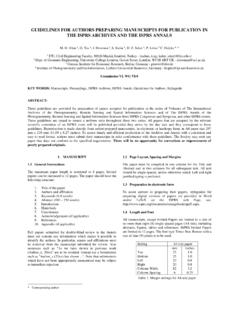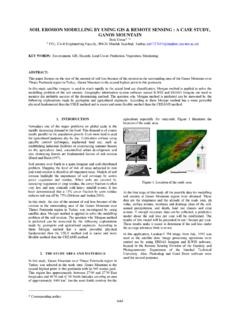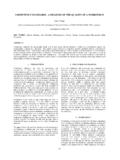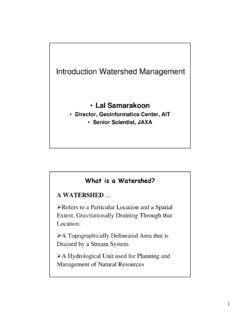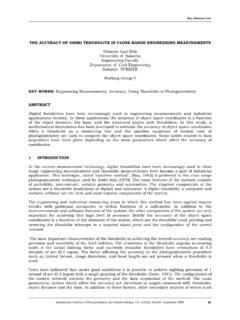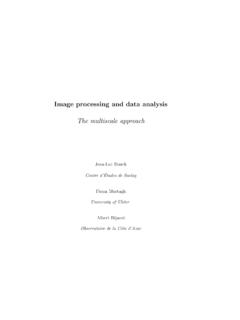Transcription of TWELVE DIFFERENT INTERPOLATION METHODS: A …
1 TWELVE DIFFERENT INTERPOLATION METHODS: A C ASE ST U D Y O F S UR FE R 8. 0 Chin-Shung Yang* Szu-Pyng Kao* Fen-Bin Lee** Pen-Shan Hung** *National Chung Hsing University, Taichung, Taiwan, ROC **Feng Chia University, Taichung, Taiwan, ROC KEY WORDS: DTM (digital terrain model), INTERPOLATION ABSTRACT SURFER is a contouring and 3D surface mapping program, which quickly and easily transforms random surveying data, using INTERPOLATION , into continuous curved face contours. In particular, the new version, SURFER , provides over TWELVE INTERPOLATION methods, each having specific functions and related parameters. In this study, the 5 meter DTM was used as test data to compare the various INTERPOLATION results; the accuracy of these results was then discussed and evaluated.
2 1 . I NT R O D U C T I O N How to adequately use exist numerous wide-distributed height points has been an important topic in the field of spatial information. Normally, contouring is the way to accurately describe the terrain relief by means of Scenography, Shading, Hachure and Layer Tinting in a way which is best fit to the habit of human vision. Presently, discretely collected height points have to be interpolated to form curved faces, the selection of spatial INTERPOLATION methods decide the quality, accuracy and follow-up analysis applications. INTERPOLATION methods are used here to calculated the unknown heights of interested points by referring to the elevation information of neighboring points.
3 There are a great many commercial INTERPOLATION software, however, most of them are tiny and designed to solve specific problems with limited versatility. The SURFER is a software developed by US GOLDEN company, and the newest version contains up to 12 INTERPOLATION methods to been free chosen for various needs. Users are suggested to first have the basic understanding of every INTERPOLATION methods before he or she can effectively select parameters in every INTERPOLATION methods. In the following paper, we will introduce every INTERPOLATION method in SURFER. 2. SURFER INTERPOLATION METHODS The Inverse Distance to a Power method The Inverse Distance to a Power method is a weighted average interpolator, which can be either exact or smoothing.
4 With Inverse Distance to a Power, data are weighted during INTERPOLATION , so that the influence of one point, relative to another, declines with distance from the grid node. Weighting is assigned to data through the use of a weighting power, which controls how the weighting factors drop off as distance from the grid node increases. The greater the weighting power, the less effect the points, far removed from the grid node, have during INTERPOLATION . As the power increases, the grid node value approaches the value of the nearest point. For a smaller power, the weights are more evenly distributed among the neighboring data points.
5 Normally, Inverse Distance to a Power behaves as an exact interpolator. When calculating a grid node, the weights assigned to the data points are fractions, the sum of all the weights being equal to When a particular observation is coincident with a grid node, the distance between that observation and the grid node is , that observation is given a weight of ; all other observations are given weights of Thus, the grid node is assigned the value of the coincident observation. The smoothing parameter is a mechanism for buffering this behavior. When you assign a non-zero smoothing parameter, no point is given an overwhelming weight, meaning that no point is given a weighting factor equal to One of the characteristics of Inverse Distance to a Power is the generation of "bull's-eyes" surrounding the observation position within the grid area.
6 A smoothing parameter can be assigned during Inverse Distance to a Power to reduce the "bull's-eye" effect by smoothing the interpolated grid. The Kriging Method Kriging is a geostatistical gridding method that has proven useful and popular in many fields. This method produces visually appealing maps from irregularly spaced data. Kriging attempts to express trends suggested in your data, so that, for example, high points might be connected along a ridge rather than isolated by bull's-eye type contours. Kriging is a very flexible gridding method. The Kriging defaults can be accepted to produce an accurate grid of your data, or Kriging can be custom-fit to a data set, by specifying the appropriate variogram model.
7 Within SURFER, Kriging can be either an exact or a smoothing interpolator, depending on the user-specified parameters. It incorporates anisotropy and underlying trends in an efficient and natural manner. The Minimum Curvature Method Minimum Curvature is widely used in the earth sciences. The interpolated surface generated by Minimum Curvature is analogous to a thin, linearly elastic plate passing through each of the data values, with a minimum amount of bending. Minimum Curvature generates the smoothest possible surface while attempting to honor your data as closely as possible. Minimum Curvature is not an exact interpolator, however.
8 This means that your data are not always honored exactly. The Modified Shepard's Method The Modified Shepard's Method uses an inverse distance weighted least squares method. As such, Modified Shepard's Method is similar to the Inverse Distance to a Power interpolator, but the use of local least squares eliminates or reduces the "bull's-eye" appearance of the generated contours. Modified Shepard's Method can be either an exact or a smoothing interpolator. The Surfer algorithm implements Franke and Nielson's (1980) Modified Quadratic Shepard's Method with a full sector search as described in Renka (1988). The Natural Neighbor Method The Natural Neighbor method is quite popular in some fields.
9 What is the Natural Neighbor INTERPOLATION ? Consider a set of Thiessen polygons (the dual of a Delaunay triangulation). If a new point (target) were added to the data set, these Thiessen polygons would be modified. In fact, some of the polygons would shrink in size, while none would increase in size. The area associated with the target's Thiessen polygon that was taken from an existing polygon is called the "borrowed area." The Natural Neighbor INTERPOLATION algorithm uses a weighted average of the neighboring observations, where the weights are proportional to the "borrowed area". The Natural Neighbor method does not extrapolate contours beyond the convex hull of the data locations ( the outline of the Thiessen polygons).
10 The Nearest Neighbor Method The Nearest Neighbor method assigns the value of the nearest point to each grid node. This method is useful when data are already evenly spaced, but need to be converted to a SURFER grid file. Alternatively, in cases where the data are close to being on a grid, with only a few missing values, this method is effective for filling in the holes in the data. Sometimes with nearly complete grids of data, there are areas of missing data that you want to exclude from the grid file. In this case, you can set the Search Ellipse to a certain value, so the areas of no data are assigned the blanking value in the grid file.
